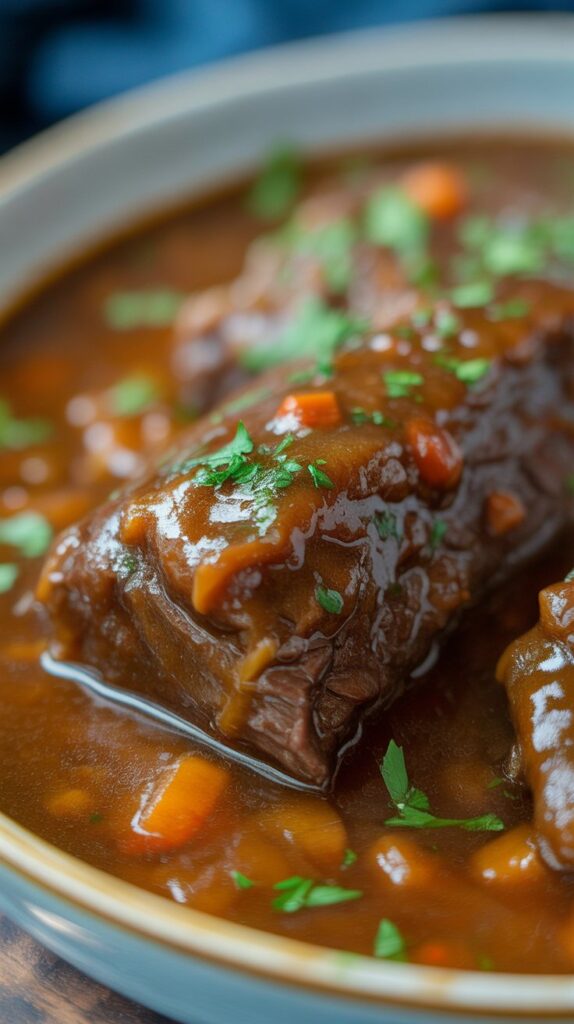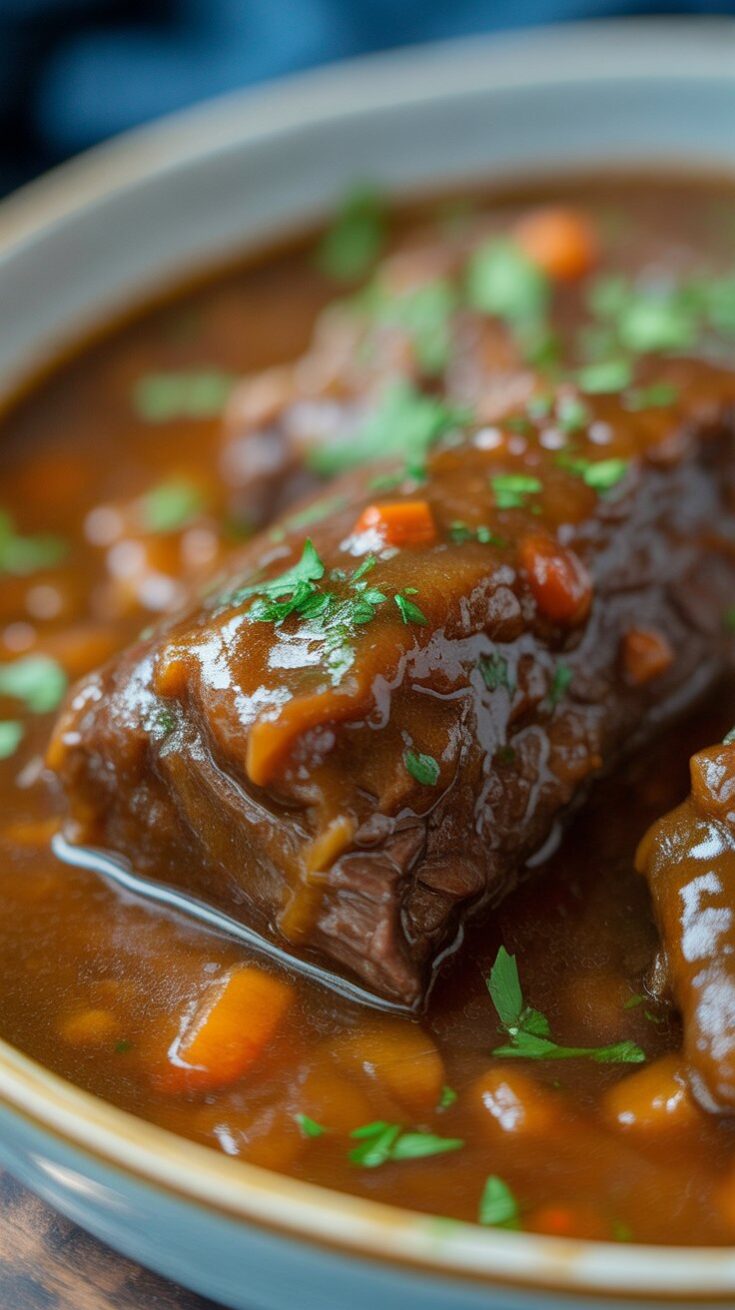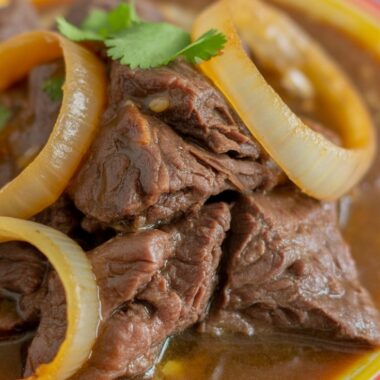This Beef Mechado is one of those dishes that makes you pause at the first spoonful—rich, savory, and just downright comforting. It’s a slow-simmered Filipino beef stew in a tomato-based sauce, best served with a warm mound of rice (or two). Growing up, this wasn’t something we had every day—it was more of a Sunday dish. You know, when the house smelled amazing for hours and everyone hovered around the kitchen, hungry and hopeful.

A Little Backstory to the Dish
The word mechado comes from the Spanish word mecha, which means wick—like a candle wick. Traditionally, pork fat was inserted into beef chunks to mimic the look of a wick and keep the meat juicy. That method isn’t used much anymore, but the spirit of the dish—tender beef simmered in tangy tomato sauce with hearty potatoes—remains the same.
These days, I skip the larding but still go for the slow-cooked tenderness. And when I say slow, I mean it—it usually takes me about 90 minutes. Worth every minute though, especially when you catch that deep aroma of garlic, onions, and stewing beef mingling in the air.
Why I Love Making This Dish at Home
- It’s pure comfort food. That tomato sauce soaked into beef and potatoes is the kind of meal you want on a rainy day.
- Meal-in-a-bowl vibe. Protein, veggies, and carbs all together—especially when you scoop it up with steaming rice.
- Great for weekends or gatherings. Since it takes time to cook, I usually save it for Sundays or when we have guests over.
- Flexible ingredients. You can toss in carrots, bell peppers, or even swap beef for pork or chicken.

What You’ll Need to Make It
- Beef: I usually go with beef chuck or brisket, cut into cubes. It holds up beautifully to long simmering.
- Tomatoes or Tomato Sauce: Fresh chopped tomatoes work great, but canned tomato sauce is a time-saver.
- Onions & Garlic: For the base aromatics—don’t skimp on these.
- Potatoes: These soak up the sauce and make the meal hearty.
- Lemon rind or calamansi juice: A little acidity gives the dish its signature depth.
- Soy sauce, bay leaves, salt, pepper: All standard pantry players.
- Optional extras: Bell peppers, carrots, green peas—or even a splash of Worcestershire for added depth.
How I Cook My Beef Mechado
1. Sauté the Aromatics and Beef
Start by heating a bit of oil in a heavy-bottomed pot. I always soften the onions first—it brings out their sweetness. Then in goes the garlic, and finally the beef. Brown it well on all sides. That caramelized crust adds loads of flavor later.
2. Add the Tomato Base
Once the beef has browned, pour in your tomato sauce and some water—enough to just cover the beef. Drop in the bay leaves and bring it all to a gentle boil.
3. Let It Simmer and Soften
This is the long-haul part. Cover, reduce the heat, and let the beef cook low and slow for about an hour to 90 minutes. Stir occasionally and top up with water if the sauce reduces too much. I usually cook rice during this downtime.
4. Add Veggies and Finish Seasoning
Once the beef is nearly fork-tender, add in the potato chunks and any other vegetables. Simmer until they’re cooked through, and taste for salt, pepper, and a squeeze of calamansi or lemon. That little bit of citrus at the end brings the whole thing together.

Ingredient Spotlights & Why They Matter
Tomatoes
The heart of the dish. Whether you use fresh or canned, they create that rich, tangy backbone of the sauce. Tomatoes are also packed with lycopene and Vitamin C—not that we need more reasons to eat them.
Potatoes
They soak up the sauce like little flavor bombs. And let’s be honest—there’s just something satisfying about cutting into a chunk of potato that’s soft but still holds its shape.
Lemon or Calamansi
This sets mechado apart from other stews like caldereta. It adds brightness to the richness, and I find it balances the beef beautifully.
Try These Variations
- Pork Mechado: Pork shoulder works great and is faster to tenderize.
- With Carrots and Bell Peppers: I throw these in when I want more color or if I have them lying around.
- Spicy Version: A little chili or hot sauce goes a long way if you like heat.
Mechado vs. Kaldereta vs. Afritada
It’s true—Filipino stews can look pretty similar, but they’ve each got their quirks:
- Mechado uses soy sauce, lemon rind or juice, and usually sticks to beef or pork.
- Kaldereta often includes liver spread or peanut butter and is more common with goat meat or beef. It’s also the spiciest of the bunch.
- Afritada is the most everyday-friendly. Usually made with chicken or pork, and it often has hotdogs, green peas, and bell peppers.
They all share a tomato base, but the flavor profiles are quite different once you get to know them.
Tips From My Kitchen
- Use a pressure cooker if you’re short on time—it cuts the cook time by over half.
- Cook your rice early. I’ve forgotten to do this more than once while being caught up in the stew.
- Let it rest. Mechado actually tastes even better the next day.
- Don’t rush the simmer. The longer the beef cooks gently, the more melt-in-your-mouth it becomes.
- Make a big batch. This keeps well and makes for an amazing baon (lunch) the next day.
Mechado Filipino Beef Stew

A hearty and comforting Filipino dish, beef mechado is all about tender chunks of beef slowly simmered in a rich tomato-based sauce.
Ingredients
- 2 lbs beef chuck, cut into cubes
- 3 tablespoons cooking oil
- 3 cloves garlic, crushed
- 1 large potato, sliced into thick rounds
- 1 large onion, thinly sliced
- 8 oz tomato sauce
- 1 cup water (plus more as needed)
- 1 slice of lemon (keep the rind on)
- 1/4 cup soy sauce
- 2 bay leaves
- 1/2 teaspoon ground black pepper
- Salt, to taste
Instructions
- Warm the oil in a deep pan over medium heat. Add the crushed garlic and sliced onions, sautéing until the onions soften and the garlic becomes fragrant.
- Toss in the cubed beef and let it brown slightly, stirring occasionally until all sides are no longer pink.
- Pour in the tomato sauce and water. Let the mixture come to a gentle boil, then lower the heat to simmer. Cover and cook until the beef turns fork-tender—this usually takes around 1 to 2 hours depending on the cut. You can add more water as needed during the simmering process.
- Once the meat is soft, season the stew with soy sauce, black pepper, lemon slice (rind included), bay leaves, and a bit of salt. Continue simmering until the sauce thickens slightly and some of the liquid has cooked down.
- Add in the potato slices and let them cook in the sauce until tender, about 10–15 minutes more.
- When everything is beautifully tender and flavorful, transfer the beef mechado to a serving dish and enjoy hot with steamed white rice.
Nutrition Information:
Yield: 6 Serving Size: 1Amount Per Serving: Calories: 425Total Fat: 18gSaturated Fat: 5gTrans Fat: 1gUnsaturated Fat: 12gCholesterol: 150mgSodium: 983mgCarbohydrates: 16gFiber: 2gSugar: 3gProtein: 52g
Asianplated.com, occasionally offers nutritional information for recipes contained on this site. This information is provided as a courtesy and is an estimate only. This information comes from online calculators. Although allchickenrecipes.com attempts to provide accurate nutritional information, these figures are only estimates.
Try This Beef Mechado at Home
If you haven’t made mechado before, I hope this version convinces you it’s worth the wait. It’s that kind of meal that fills both your belly and your kitchen with warmth. If you do try it, I’d love to hear how it turns out for you—or what little twists you added.
Now go make some rice—you’ll need it.
Try other Filipino recipes:


















